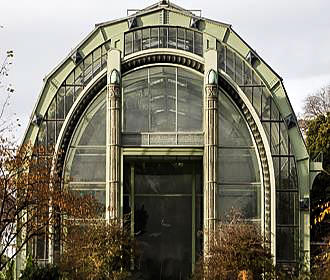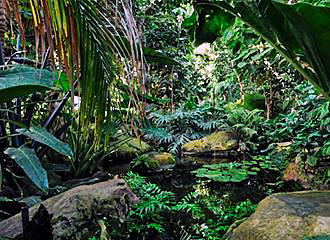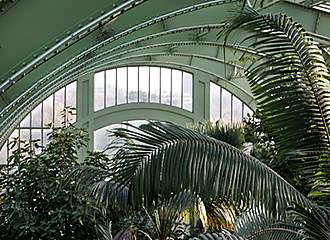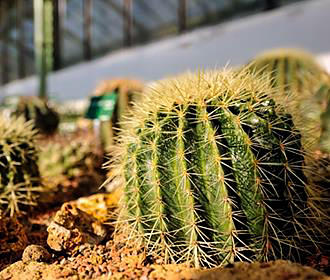Les Grandes Serres inside the Jardin des Plantes
The Greenhouses of the Jardin des Plantes have been classified as historical monuments in Paris with the metal greenhouses constructed in the 1800s being the largest of their kind in the world at the time, and with major renovations having been undertaken, Les Grandes Serres are now open to the public again, including its museum, providing visitors an insight into biodiversity throughout the world.
A bit of history
It originally started with orange trees that were the first fragile plants to be introduced to the Royal Garden, which is now known as the Jardin des Plantes, and in order to protect them frosts, buildings referred to as orangeries were constructed.
Yet it was only later on that buildings made of wood and glass were constructed, and it was these that were the first type of greenhouse designed to preserve and acclimatise different plants that were brought back from expeditions and voyages of exploration.
You will find that the oldest greenhouse was constructed by Sebastien Vaillant in 1714 and was used for coffee for King Louis XIV, and over the years additional greenhouses were constructed within the royal botanical garden for the reigning kings.
However, by the start of the 1800s it was figured out that the use of glass and metal together would provide stronger structures and better insulation for plants that required heat. So the architect Charles Rohault de Fleury went to England in 1833 to study the system that had been adopted at Kew Gardens.
Upon his return, during the years of 1834 through to 1836 two greenhouses heated by steam were constructed within the Jardin des Plantes, with the eastern pavilion later being called the Mexican Greenhouse and the western pavilion being the Australian Greenhouse. These two pavilions were like the prototypes for modern greenhouses and were at the time, the largest greenhouses in the world made of glass and metal.
Technical knowhow in construction progressed over the years, which meant that curves could be integrated into the greenhouses and during the latter part of the 1800s the first winter garden was constructed by Jules Andre. Then this was replaced with an art deco style winter garden of the museum in the 1930s, which is now known as the Serre Rainforests.
Of course, the Serres, or Greenhouses, have been altered and had major restoration over the years, yet they are also classified as historical monuments in Paris, which eventually reopened to the public after almost six years of extensive renovations to the buildings, along with the layout ensuring a better visitor experience to this living museum in Paris.
About the Grandes Serres in Paris
The Greenhouses were fully renovated and once again opened to the public in the June of 2010, and fully restored to their former glory, yet providing a new design, the whole family can now discover plant diversity from different areas of the world through different areas dedicated to specific climates and plants.
The former Winter Garden is now known as the Rainforest Greenhouse, which is where your visit will start, and where you can discover a moist atmosphere of the tropical ecosystem and from Africa to America and even Southeast Asia, you can discover hundreds of different species of plants and trees including banana trees, orchids, ferns, etc, plus you can climb a rock to see a panorama of this specific greenhouse area.
Next to this within Les Grandes Serres there is a long gallery that represents the deserts of America, Australia, Mexico, the Andes, Madagascar and the Sahara where you can discover plants such as cacti and others designed to survive in harsh arid climates.
Also, within its own area and in its own greenhouse is a section dedicated to New Caledonia, which was formerly the old Mexican Greenhouse. Due to the fact that there are approximately 76 percent of plant species that are found nowhere else on the planet except for within the Oceania Archipelago, this is well deserved. This means it allows the visitor to experience some very rare and endangered species of plants from different areas such as mangroves through to rainforest and the dry forest, which is the most critically endangered.
And classed as one of the museums in Paris, the last area of Les Grandes Serres that you can discover is related to the history of the evolution of plants and how they have adapted and evolved over the millions of years on earth, plus how they play a major role in the ecosystem.
Visiting the Grandes Serres in Paris
As you have no doubt already realised, the Grandes Serres are located within the Jardin des Plantes, which is in the 5th Arrondissement of Paris only a few steps from the River Seine and it is open on a Wednesday through to a Monday, yet is closed on a Tuesday along with certain National French holidays such as 1st May.
The opening times are from 10am through to 5pm in Spring, Autumn and Winter, yet it does not close until 6pm during the Summer months. However we would like to point out that in cases of severe weather conditions such as bad snow, high winds or even a major heat wave, the Grandes Serres can be closed indefinitely, so you can always telephone +33 (0) 1 40 79 56 01 to check that this and the Jardin des Plantes is open prior to arrival.
Now the cost of entry is €7 as of 2020, with a reduced rate of €5 for children under the age of sixteen or up to the age of 24 if in full time education, however, it is free to children under the age of 4 and those that are disabled, but the ticket office closes a minimum of 45 minutes prior to Les Grandes Serres closing.
When it comes to enjoying the Greenhouses of the Jardin des Plantes and its numerous other attractions like the Natural History Museum and you wish to arrive via Paris public transport, you will find that the Gare d'Austerlitz train station is located close by and serves Metro lines 5 and 10 along with serving the RER C train line as well as TER and Intercites trains to other regions of France.
Yet there are also two Metro stations close to Jardin des Plantes and the Grandes Serres being the Jussieu stop serving lines 7 and 10 and the Censier-Daubention stop serving line 7.
However you also have the option of the Paris buses, with bus line 24, 57, 61, 63, 89, 91 and 215 all being very close by, as the Noctilien night buses via line N01, N02 and N31 for those leaving the area late at night.
Although, for a more unusual mode of public transport you could enjoy the Batobus, which is the water bus that offers a hop on and hop off service along the River Seine stopping at key points close to many popular tourist attractions in Paris including the Jardin des Plantes, the famous Eiffel Tower and the impressive Louvre Museum.



